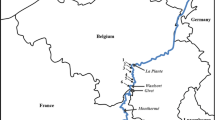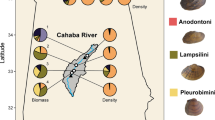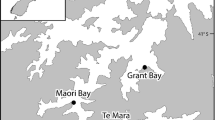Abstract
The ecological impact of dreissenid mussel (e.g., quagga and zebra) populations and their empty shells on native fauna in large rivers and lakes has been extensively studied. However, there is limited information on their effects in small wadable streams. Although established mussel populations in these systems are uncommon, their shells are found in high densities in benthic environments and may adversely impact stream communities. Shell densities were quantified using quadrats in two wadable streams to assess impacts on native benthic macroinvertebrates and fish. Eight reaches of each river were sampled, four with dreissenids and four without, totaling 16 locations. Macroinvertebrate and fish communities were characterized using diversity and environmental tolerance indices. Shell densities were significantly higher in dreissenid-invaded sites compared to sites with only native bivalves in both rivers. Dense shell beds had degraded biological conditions with fewer sensitive macroinvertebrates, but bed density did not affect overall macroinvertebrate or fish diversity. These findings differ from lake and large river studies, which found a greater impact of dreissenid shell deposition on macroinvertebrate and fish diversity than we observed in small wadable streams. Thus, a different approach to management and restoration may be necessary to maintain a natural community composition in wadable streams.




Similar content being viewed by others
Data availability
The data package for this work is available at the Environmental Data Initiative (EDI) public data repository (Hunt and Kashian, 2024). R code for statistical analysis will be made available upon reasonable request to the authors.
References
Akaike, H., 1976. Canonical correlation analysis of time series and the use of an information criterion. In Mehra, R. K. & D. G. Lainiotis (eds), System Identification Academic Press, New York: 27–96.
Barbour, M. T., C. G. Graves, J. L. Plafkin, R. W. Wisseman & B. P. Bradley, 1992. Evaluation of EPA’s rapid bioassessment benthic metrics: metric redundancy and variability among reference stream sites. Environmental Toxicology and Chemistry 11: 437–449.
Barbour, M. T., J. Gerritson, B. D. Snyder & J. B. Stribling, 1999. Rapid Bioassessment Protocols for Use in Streams and Wadable Rivers: Periphyton, Benthic Macroinvertebrates and Fish, 2nd ed. EPA 841-B-99-002.
Bayley, P. & R. Herendeen, 2000. The efficiency of a seine net. Transactions of the American Fisheries Society. 129: 901–923.
Beekey, M. A., D. J. McCabe & J. E. Marsden, 2004. Zebra mussels affect benthic predator foraging success and habitat choice on soft sediments. Oecologia 141(1): 164–170.
Beam, J. D. & J. J. Braunscheidel. 1998. Rouge River Assessment. Michigan Department of Natural Resources, Fisheries Division, Special Report 22. Ann Arbor, Michigan.
Botts, P. S., B. A. Patterson & D. W. Schlosser, 1996. Zebra mussel effects on benthic invertebrates: physical or biotic? Journal of the North American Benthological Society 15: 179–184.
Bossenbroek, J. M., L. E. Johnson, Brett Peters & D. M. Lodge, 2007. Forecasting the expansion of zebra mussels in the United States. Conservation Biology 21(3): 800–810.
Brown, D. 2021. Home – Huron River Watershed Council. Together we protect our home, Huron River Watershed Council.
Brown, B. L. & R. L. Lawson, 2010. Habitat heterogeneity and activity of an omnivorous ecosystem engineer control stream community dynamics. Ecology 91(6): 1799–1810.
Burdon, F. J., McIntosh, A. R., & Harding, J. S. (2016). Habitat loss drives threshold response of benthic invertebrate communities to deposited sediment in agricultural streams. Wiley. https://doi.org/10.6084/m9.figshare.c.3295934.v1
Carr, J. P., 2009. Turning the tide on aquatic invaders. BioScience 59(10): 830–830. https://doi.org/10.1525/bio.2009.59.10.4.
Chornesky, E. A. & J. M. Randall, 2003. The threat of invasive alien species to biological diversity: setting a future course. Annals of the Missouri Botanical Garden 90(1): 67–76. https://doi.org/10.2307/3298527.
Dewey, M. R., L. E. Holland-Bartels & S. J. Zigler, 1989. Comparison of fish catches with buoyant pop nets and seines in vegetated and nonvegetated habitats. North American Journal of Fisheries Management 9: 249–253.
Enders, E. C., C. Charles, A. L. Caskenette, T. A. Rudolfsen & D. A. Watkinson, 2019. Distribution patterns of the early invasion of zebra mussels, Dreissena polymorpha (Pallas, 1771), in the south basin of Lake Winnipeg. BioInvasions Records 8: 329–342.
Ferreira, W. R., R. Ligeiro, D. R. Macedo, R. M. Hughes, P. R. Kaufmann, L. G. Oliveira & M. Callisto, 2014. Importance of environmental factors for the richness and distribution of benthic macroinvertebrates in tropical headwater streams. Freshwater Science 33(3): 860–871. https://doi.org/10.1086/676951.
Ferro, M. L. & R. W. Sites, 2007. The Ephemeroptera, Plecoptera, and Trichoptera of Missouri State Parks, with notes on biomonitoring, mesohabitat associations, and distribution. Journal of the Kansas Entomological Society 80(2): 105–129.
Fields, S., 2005. Great lakes: resource at risk. Environmental Health Perspectives 113(3): A165–A173.
Flotemersch, J. E., & S. M. Cormier. (2001). Comparisons of boating and wading methods used to assess the status of flowing waters. U.S. Environmental Protection Agency, 600/R-00/108, Washington, D.C.
Fox, J., 2005. The R commander: a basic statistics graphical user interface to R. Journal of Statistical Software 14: 1–42.
Fox, J., 2017. Using the R Commander: A Point-and-Click Interface or R, Chapman and Hall, Boca Raton:
Fox, J., & M. Bouchet-Valat. (2020). Rcmdr: R Commander. R package version 2.7–1.
Frye, C., D. J. Wright, E. Nordstrand, C. Terborgh & J. Foust, 2018. Using classified and unclassified land cover data to estimate the footprint of human settlement. Data Science Journal 17: 20.
Gordon, N. D., T. A. McMahon, B. L. Finlayson, C. J. Gippel & R. J. Nathan, 2004. Stream Hydrology: An Introduction for Ecologists, Wiley, Hoboken:
Gorman, O. T. & J. R. Karr, 1978. Habitat structure and stream fish communities. Ecology 59(3): 507–515. https://doi.org/10.2307/1936581.
Gutiérrez, J. L., C. G. Jones, D. L. Strayer & O. O. Iribarne, 2003. Mollusks as ecosystem engineers: the role of shell production in aquatic habitats. Oikos 101: 79–90.
Haubrock, P. J., I. Soto, M. Kourantidou, D. A. Ahmed, A. Serhan Tarkan, P. Balzani, K. Bego, A. Kouba, S. Aksu, E. Briski, F. Sylvester, V. De Santis, G. Archambaud-Suard, N. Bonada, M. Cañedo-Argüelles, Z. Csabai, T. Datry, M. Floury, J. F. Fruget, J. I. Jones, M. H. Lizee, J. F. Murphy, O. Davis, J. J. Rasmussen, A. Skuja, V. Gábor, P. Verdonschot, C. M. Ralf, P. Wiberg-Larsen & R. N. Cuthbert, 2024. Understanding the complex dynamics of zebra mussel invasions over several decades in European rivers: drivers, impacts and predictions. Oikos. https://doi.org/10.1111/oik.10283.
Hay-Chmielewski, E.M. G.E. Seelbach, D.B. Whelan, & Jester. 1996. Huron River Assessment. Michigan Department of Natural Resources, Fisheries Division, Special Report 16. Ann Arbor, Michigan.
Holland-Bartels, L. E. & M. R. Dewey, 1997. The Influence of seine capture efficiency on fish abundance estimates in the upper Mississippi River. Journal of Freshwater Ecology 12(1): 101–111.
Higgins, S. N. & M. J. Vander Zanden, 2010. What a difference a species makes: a meta–analysis of dreissenid mussel impacts on freshwater ecosystems. Ecological Monographs 80(2): 179–196.
Holeck, K. T., E. L. Mills, H. J. MacIssac, M. R. Dochoda, R. I. Colautti & A. Ricciardi, 2004. Bridging troubled waters: biological invasions, transoceanic ship**, and the Laurentian Great Lakes. BioScience 54: 919.
Horvath, T. G., G. A. Lamberti, D. M. Lodge & W. L. Perry, 1996. Zebra mussel dispersal in lake-stream systems: source-sink dynamics? Journal of the North American Benthological Society 15: 564–575.
Hunt, D. S., & D. R. Kashian. 2024. Dreissenid mussel shell deposition, and benthic community data in the Rouge and Huron Rivers, Southeastern, MI., USA. ver 2. Environmental Data Initiative. https://doi.org/10.6073/pasta/cb5e2fbdc457eec55047c0e5785323d0. Accessed 22 Feb 2024.
Jørgensen, C., E. S. Dunlop, A. F. Opdal & Ø. Fiksen, 2008. The evolution of spawning migrations: state dependence and fishing-induced changes. Ecology 89(12): 3436–3448.
Karatayev, A. Y., L. E. Burlakova, S. E. Mastitsky & D. K. Padilla, 2015. Predicting the spread of aquatic invaders: insight from 200 years of invasion by zebra mussels. Ecological Applications 25(2): 430–440.
Karr, J. R., K. D. Fausch, P. L. Angermeier, P. R. Yant & I. J. Schlosser, 1986. Assessing biological integrity in running waters: a method and its rationale. Illinois Natural History Survey Special Publication 5: 1–28.
Kobak, J., M. Poznanska, L. Jermacz, T. Kakareko, D. Pradzynski, M. Lodygowska, K. Montowska & K. Bacela-Spychalska, 2016. Zebra mussel beds: an effective feeding ground for Ponto-Caspian gobies or suitable shelter for their prey? PeerJ 4: 2672.
Kuznetsova, A., P. B. Brockhoff & R. H. B. Christensen, 2017. lmerTest Package: tests in linear mixed effects models. Journal of Statistical Software. 82: 1–26.
Lei, C. & Z. Laiyin, 2017. Spatio-temporal variability of land use/land cover change (LULCC) within the Huron River: Effects on stream flows. Climate Risk Management. https://doi.org/10.1016/j.crm.2017.09.002.
Lenth, R. V. 2021. Emmeans: Estimated Marginal Means, aka Least-Squares Means. R package version 1.6.2–1.
Lepori, F., D. Palm, E. Brännäs & B. Malmqvist, 2005. Does restoration of structural heterogeneity in streams enhance fish and macroinvertebrate diversity? Ecological Applications 15(6): 2060–2071.
Li, J., V. Ianaiev, A. Huff, J. Zalusky, T. Ozersky & S. Katsev, 2021. Benthic invaders control the phosphorus cycle in the world’s largest freshwater ecosystem. Proceedings of the National Academy of Sciences of the United States of America 118(6): 1–9.
Limburg, K. E. & R. E. Schmidt, 1990. Patterns of fish spawning in Hudson river tributaries: response to an urban gradient? Ecology 71(4): 1238–1245. https://doi.org/10.2307/1938260.
Lucas, M. C. & E. Batley, 1996. Seasonal movements and behaviour of adult barbel Barbus barbus, a riverine cyprinid fish: implications for river management. Journal of Applied Ecology 33(6): 1345–1358. https://doi.org/10.2307/2404775.
Ludyanskiy, M. L., D. McDonald & D. MacNeill, 1993. Impact of the zebra mussel, a bivalve invader. BioScience 43(8): 533–544. https://doi.org/10.2307/1311948.
MacIsaac, H. J., 1996. Potential abiotic and biotic impacts of zebra mussels on the inland waters of North America. American Zoologist 36(3): 287–299. https://doi.org/10.1093/icb/36.3.287
Marsden, E. J. & M. A. Chotkowski, 2001. Lake trout spawning on artificial reefs and the effect of zebra mussels: fatal attraction? Journal of Great Lakes Research 27: 33–43.
Matthews, J., G. Van der Velde, A. Bij De Vaate, F. P. L. Collas, K. R. Koopman & R. S. E. W. Leuven, 2014. Rapid range expansion of the invasive quagga mussel in relation to zebra mussel presence in The Netherlands and Western Europe. Biological Invasions 16(1): 23–42. https://doi.org/10.1007/s10530-013-0498-8.
Mayer, C. M., R. A. Keats, L. G. Rudstam & E. L. Mills, 2002. Scale-dependent effects of zebra mussels on benthic invertebrates in a large eutrophic lake. Journal of the North American Benthological Society 21(4): 616–633. https://doi.org/10.2307/1468434.
McCormick, M. 2021. Our watershed. Friends of the Rouge.
Merritt, R. W., & K. W. Cummins. 1996. An introduction to the aquatic insects of North America. Kendall Hunt.
Morley, S. A. 2000. Effects of urbanization on the biological integrity of Puget Sound lowland streams: Restoration with a biological focus.
Nakano, D. & D. L. Strayer, 2014. Biofouling animals in freshwater: biology, impacts, and ecosystem engineering. Frontiers in Ecology and the Environment 12(3): 167–175.
Nalepa, T. F. & G. L. Fahnenstiel, 1995. Dreissena polymorpha in the Saginaw bay, lake Huron ecosystem: overview and perspective. Journal of Great Lakes Research 21: 411–416.
Napieralski, J., R. Keeling, M. Dziekan, C. Rhodes, A. Kelly & K. Kobberstad, 2015. Urban stream deserts as a consequence of excess stream burial in urban watersheds. Annals of the Association of American Geographers. https://doi.org/10.1080/00045608.2015.1050753.
Nguyen-Feng, V. & M. A. Stellmack, 2016. A Guide to Data Analysis in R Commander, University of Minnesota, Minneapolis:
Padilla, D. K., M. A. Chotkowski & Lucy A. J. Buchan, 1996. Predicting the spread of zebra mussels (Dreissena polymorpha) to inland waters using boater movement patterns. Global Ecology and Biogeography Letters 5(6): 353–359. https://doi.org/10.2307/2997590.
Patrick, R. & D. M. Palavage, 1994. The value of species as indicators of water quality. Proceedings of the Academy of Natural Sciences of Philadelphia 145: 55–92.
Poff, N. L., J. D. Allan, M. B. Bain, J. R. Karr, K. L. Prestegaard, B. D. Richter, R. E. Sparks & J. C. Stromberg, 1997. The natural flow regime. BioScience 47(11): 769–784. https://doi.org/10.2307/1313099.
Rankin, E. 1989. Method for Assessing Habitat in Flowing Waters: Using the Qualitative Habitat Evaluation Index (QHEI). State of Ohio Environmental Protection Agency Division of Surface Water.
R Core Team. 2021. R: A Language and Environment for Statistical Computing. R Foundation for Statistical Computing, Vienna, Austria. https://www.R-project.org/.
Rstudio Team. 2020. Rstudio: Integrated Development for R. Rstudio, PBC, Boston, MA. http://www.rstudio.com/.
Ricciardi, A., R. J. Neves & J. B. Rasmussen, 1998. Impending extinctions of north American freshwater mussels (Unionoida) following the zebra mussel (Dreissena polymorpha) invasion. Journal of Animal Ecology 67(4): 613–619.
Schneider, D. W., C. D. Ellis & K. S. Cummings, 1998. A transportation model assessment of the risk to native mussel communities from zebra mussel spread. Conservation Biology 12(4): 788–800.
Smith, B. R., D. R. Edds & J. M. Goeckler, 2015. Lowhead dams and the downstream dispersal of zebra mussels. Hydrobiologia 755: 1–12.
Soulsby, C., A. F. Youngson, H. J. Moir & I. A. Malcolm, 2001. Fine sediment influence on salmonid spawning habitat in a lowland agricultural stream: a preliminary assessment. Science of the Total Environment 265(1–3): 295–307.
Stewart, T. W., J. G. Miner & R. L. Lowe, 1998. Quantifying mechanisms for zebra mussel effects on benthic macroinvertebrates: organic matter production and shell-generated habitat. Journal of the North American Benthological Society 17(1): 81–94. https://doi.org/10.2307/1468053.
Strayer, D. L., N. F. Caraco, J. J. Cole, S. Findlay & M. L. Pace, 1999. Transformation of freshwater ecosystems by bivalves: a case study of zebra mussels in the Hudson river. BioScience 49(1): 19–27. https://doi.org/10.1525/bisi.1999.49.1.19.
Strayer, D. L., 1999. Effects of alien species on freshwater Mollusks in North America. Journal of the North American Benthological Society 18(1): 74–98. https://doi.org/10.2307/1468010.
Strayer, D. L. & H. M. Malcom, 2006. Long-term demography of a zebra mussel (Dreissena polymorpha) population. Freshwater Biology 51: 117–130.
Strayer, D. L., 2009. Twenty years of zebra mussels: lessons from the mollusk that made headlines. Frontiers in Ecology and the Environment 7(3): 135–141.
U.S. Geological Survey. 2019. Nonindigenous Aquatic Species Database. Gainesville, FL. 4/1/2019.
Vanni, M. J., 2021. Invasive mussels regulate nutrient cycling in the largest freshwater ecosystem on Earth. Proceedings of the National Academy of Sciences of the United States of America 118(8): 1–3.
Venables, W. N. & B. D. Ripley, 2002. Modern Applied Statistics with S, 4th ed. Springer, New York:
Wagenhoff, A., C. R. Townsend & C. D. Matthaei, 2012. Macroinvertebrate responses along broad stressor gradients of deposited fine sediment and dissolved nutrients: a stream mesocosm experiment. Journal of Applied Ecology 49(4): 892–902.
Ward, J. M. & A. Ricciardi, 2007. Impacts of Dreissena invasions on benthic macroinvertebrate communities: a meta-analysis. Diversity and Distributions 13: 155–165.
White, J. Y. & C. J. Walsh, 2020. Catchment-scale urbanization diminishes effects of habitat complexity on instream macroinvertebrate assemblages. Ecological Applications 30(8): 1–12.
Williamson, F. & T. Ozersky, 2019. Lake characteristics, population properties and invasion history determine impact of invasive bivalves on lake nutrient dynamics. Ecosystems 22(8): 1721–1735.
Wilson, S. K., R. Fisher, M. S. Pratchett, N. A. J. Graham, N. K. Dulvy, R. A. Turner, A. Cakacaka & N. V. C. Polunin, 2010. Habitat degradation and fishing effects on the size structure of coral reef fish communities. Ecological Applications 20(2): 442–451.
Wohl, E., B. P. Bledsoe, R. B. Jacobson, N. L. Poff, S. L. Rathburn, D. M. Walters & A. C. Wilcox, 2015. The natural sediment regime in rivers: broadening the foundation for ecosystem management. BioScience 65(4): 358–371.
Zhu, B., D. G. Fitzgerald, C. M. Mayer, L. G. Rudstam & E. L. Mills, 2006. Alteration of ecosystem function by zebra mussels in Oneida lake: impacts on submerged macrophytes. Ecosystems 9(6): 1017–1028.
Acknowledgements
We thank Sally Petrella and Friends of the Rouge for sharing historic dreissenid invasion data and Anna Boegehold, Corey Krabbenhoft, and Robert Roose for assistance with fish sampling. We also thank two anonymous reviewers whose detailed comments improved the quality of this manuscript. The research was supported by the National Science Foundation under Grant No. 1735038.
Author information
Authors and Affiliations
Corresponding author
Ethics declarations
Conflict of interest
Darrin Hunt and Donna Kashian do not have financial or non-financial competing interests directly or indirectly associated with this work submitted for publication.
Additional information
Handling editor: Manuel Lopes-Lima
Publisher's Note
Springer Nature remains neutral with regard to jurisdictional claims in published maps and institutional affiliations.
Supplementary Information
Below is the link to the electronic supplementary material.
Rights and permissions
Springer Nature or its licensor (e.g. a society or other partner) holds exclusive rights to this article under a publishing agreement with the author(s) or other rightsholder(s); author self-archiving of the accepted manuscript version of this article is solely governed by the terms of such publishing agreement and applicable law.
About this article
Cite this article
Hunt, D.S., Kashian, D.R. Investigating the effects of dreissenid mussel shells in streams post-invasion. Hydrobiologia (2024). https://doi.org/10.1007/s10750-024-05627-x
Received:
Revised:
Accepted:
Published:
DOI: https://doi.org/10.1007/s10750-024-05627-x




